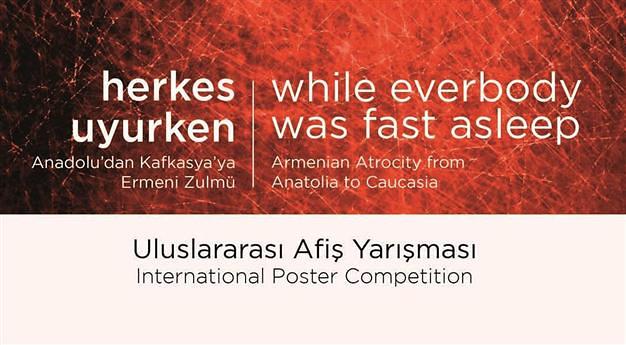University opens competition to mark ‘genocide committed by Armenians against Turks’
by Bahadır Özgür

A university in Ankara has opened a controversial poster competition to mark the 100th anniversary of the 1915 incidents from an unexpected perspective – “to remember the genocide committed by Armenians against Turks.”
The competition, titled “While Everybody was Fast Asleep: Armenian Atrocities from Anatolia to Caucasia,” will be hosted by the Fine Arts Faculty of Ankara’s Gazi University, and will be open to everybody, according to a statement from the organizers.
An exhibition will take place after the competition and the winners will be admitted to shows held in both Turkey and Azerbaijan, the statement added.
The aim of the competition is described by its organizers as being “to remind people of the genocide committed by Armenians against Turks, to halt the claims of so-called Armenian genocide and the smear campaigns, to contribute to the struggle of those who resist injustice against the Turkish nation, to make the resisters feel that they are not alone, to share the pain, and to raise consciousness and spread it to the masses.”
The statement announcing the competition was also accompanied by a lengthy interpretation of the years leading up to 1915, claiming that the Armenians experienced their history’s “Golden Age” under Ottoman rule, particularly between the 15th and 19th centuries
“During the reign of Sultan Mehmet the Conqueror, they were granted maximum freedom of thought and faith. The Armenian Patriarchate was established to manage the religious and social activities of the Armenian community. The period up until the 19th century – when they lived alongside Turks – has been recorded in history as the ‘Golden Age of Armenians,’” it said, adding that circumstances changed “with the riots of Armenians, under the inducement of some Western countries.”
“They ignited new riots in various places of Anatolia, mainly in Zeytun and the Musa Mountains, and launched attacks on the convoys carrying ammunition and food to the battlefronts. In order to prevent activities likely to harm the army, the Ottoman government decided to evacuate the Armenians living in the area of the riots, mainly in [southeastern provinces of] Van, Muş, Bitlis, Çatak and Erzurum.
Accordingly, plans were made to ensure the Armenians migration to Mosul in Iraq. The aim was not to destroy them, but to maintain state security and to protect the community,” the statement also said, referring to the forced resettling of Armenians as a “necessity.”
“Unfortunately, casualties occurred as a consequence of the attacks committed by the Armenians during their journey to the Mosul region in 1915,” said the statement, adding that these casualties were now being “exaggerated by governments and groups in a biased way.”
“While the deaths were caused by epidemic illnesses and hunger, the majority of the losses were experienced due to the Ottoman-Russian war by the Armenians escaping to the Russian side. Besides, the archive records show that around 2 million Muslims also lost their lives in similar incidents,” said the statement, adding that the Armenian casualties were not 1 million but around 50,000.
“The real sufferers of the First World War were the Turks, who had been massacred by Armenians. The Armenian gangs who organized attacks on Turkish troops at the beginning of the declaration of mobilization seriously harmed the civilians by conducting raids on Turkish villages,” said the statement.
Meanwhile, an academic from 9 Eylül University in İzmir recently made headlines after demanding that his students prepare a paper on the 1915 killings to “prove with documents that there is no Armenian Genocide.”



